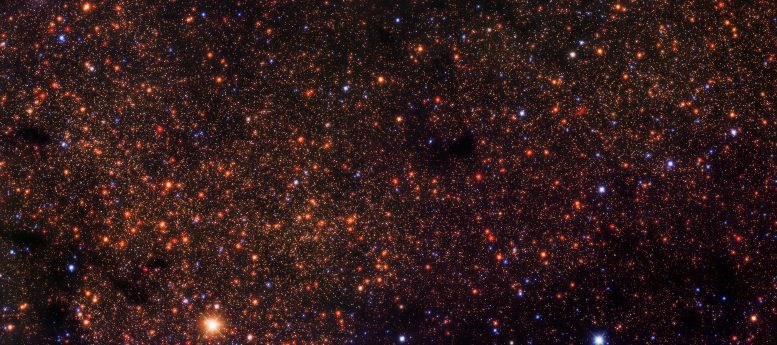
By European Southern Observatory (ESO) February 16, 2025
Collected at: https://scitechdaily.com/astronomers-uncover-a-hidden-star-cluster-that-changes-everything/
The VLT captures a stunning infrared view of Sagittarius C, exposing a rich field of young stars.
This breakthrough provides clues to the mysterious deficit of observed young stars in the Milky Way’s core, suggesting areas obscured by cosmic dust as treasure troves of astronomical secrets.
Unveiling the Heart of the Milky Way
This striking infrared image of Sagittarius C, captured by ESO’s Very Large Telescope (VLT) in Chile’s Atacama Desert, showcases hundreds of thousands of stars near the heart of the Milky Way. It offers astronomers valuable clues in solving a cosmic mystery.
The center of the Milky Way is the galaxy’s most active star-forming region. However, astronomers have only identified a small fraction of the young stars they expected to find. Fossil evidence suggests that many more stars formed in the recent past than are currently visible.
Infrared Vision: Peering Through Cosmic Dust
The challenge lies in observing this crowded region — thick clouds of dust and gas obscure the starlight, making direct observation difficult. Fortunately, infrared instruments like the VLT’s HAWK-I camera can penetrate these cosmic clouds, revealing the hidden stars beyond.

In a recent study, Francisco Nogueras Lara, an astronomer at ESO in Germany, analyzed VLT data of Sagittarius C, a region whose chemical composition made it a promising candidate to host recently formed stars. And it delivered: he found that this region was much richer in young stars than other areas in the galactic center. Looking to similar regions, now, is a promising lead to finding the other missing young stars.
Reference: “Hunting young stars in the Galactic centre – Hundreds of thousands of solar masses of young stars in the Sagittarius C region” by F. Nogueras-Lara, 23 January 2024, Astronomy & Astrophysics.
DOI: 10.1051/0004-6361/202348712

Leave a Reply